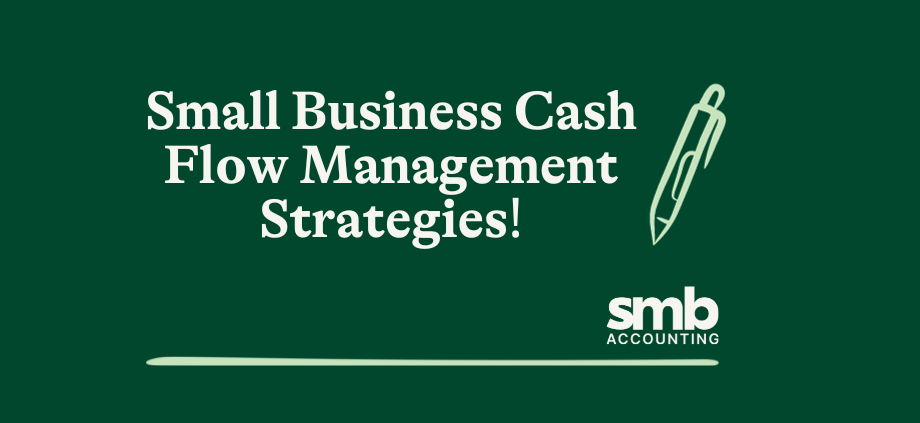Small Business Cash Flow Management: Strategies for Financial Success
Financial success is at the heart of every thriving small business, and effective cash flow management is pivotal in achieving this goal. Cash flow represents the total amount of money coming in and out of your business. Positive cash flow occurs when the money coming in exceeds the money going out, while negative cash flow indicates that the expenses outpace the income.
Managing cash flow is an ongoing challenge for many small business owners, as unforeseen expenses, economic downturns, and inadequately planned investments can threaten the financial stability of the business. With this in mind, having a clear understanding of cash flow management can make a substantial difference in driving sustainable, long-term growth.
At SMB Accounting, we are passionate about helping entrepreneurs and small business owners in Australia optimise their cash flow, uncovering potential areas of improvement and implementing strategies to maximise their financial success.
In this article, we will share essential cash flow management tips, such as developing a cash flow budget, detecting areas of potential cash leakage, tapping into short-term financing options, and leveraging technology to streamline financial processes.
1. Creating a Cash Flow Budget: Establish a Financial Roadmap
Developing a cash flow budget is the first critical step to effective cash flow management. A cash flow budget is a forward-looking financial plan that outlines the estimated inflow and outflow of cash over a specified period. Regularly reviewing and updating the budget allows you to anticipate potential cash flow challenges, freeing up resources to address them, and plan for business growth.
To create your cash flow budget, start by estimating all sources of income, such as sales, accounts receivable collections, and any other forms of revenue. Next, assess your outgoing expenses, such as the cost of goods sold, wages, rent, and operational expenses. Comparing the total income against the total expenditure will reveal your net cash flow position, indicating whether you are generating positive or negative cash flow.
Remember to update your cash flow budget regularly as revenue and expenses change, and continuously monitor your progress against the budget, making adjustments as needed to maintain financial stability.
2. Detect Cash Leakage: Identify and Address Financial Weaknesses
Cash leakage occurs when funds are escaping your business through inefficiencies and missed opportunities. Common cash leakage sources include inventory, overdue accounts receivable, and uncontrolled spending. Identifying and addressing these areas can significantly improve your cash flow and transform the financial health of your business.
To detect cash leakage, meticulously review your financial records, monitor inventory levels, and collect overdue payments from customers. Furthermore, identify areas of uncontrolled spending by examining your purchasing decisions, streamlining recurring expenses, and negotiating better terms with suppliers. Addressing these areas of cash leakage can help optimise your cash flow and set your business up for success.
3. Short-Term Financing Options: Access Additional Resources
Inevitably, small businesses may face unexpected cash flow challenges due to unforeseen circumstances or economic downturns. During these times, it’s essential to have access to short-term financing options to maintain liquidity and financial stability.
Consider exploring various short-term financing options, such as lines of credit, short-term loans, overdraft facilities, and invoice financing. Research the most suitable financing solution for your business by carefully considering each option’s associated costs, terms, and benefits.
It’s prudent to secure financing arrangements before encountering cash flow issues to ensure you have the necessary resources available when needed. Always consult with a professional accountant, like SMB Accounting, before taking on additional debt to ensure the financial impact aligns with your long-term business goals.
4. Leverage Technology: Streamline Your Financial Processes
Modern technology offers small businesses an array of financial management tools designed to streamline cash flow management and enhance financial decision-making. Accounting software, like Xero, can simplify tracking income and expenses while providing real-time insights into your cash flow position. Furthermore, these tools can seamlessly integrate with your existing systems, eliminating manual data entry and ensuring accurate record-keeping.
Cloud-based accounting software also enables efficient collaboration between team members and financial advisors regardless of physical location. This ease of access assists in staying up-to-date with your business’s financial situation and allows for swift, well-informed decisions.
Harnessing the power of technology not only simplifies cash flow management but also increases overall business efficiency, unlocking opportunities for strategic decision-making and future growth.
Cultivate Financial Success through Effective Cash Flow Management
Crafting a financially successful small business requires careful attention to cash flow management. Implementing these strategies — creating a cash flow budget, detecting cash leakage, utilising short-term financing options, and leveraging technology — can greatly enhance your business’s financial position, enabling growth and sustained success.
Navigating the complexities of cash flow management can be challenging. Partnering with an experienced accounting service, like SMB Accounting, can provide the expertise and knowledge required to help your business harness the full potential of effective cash flow management strategies. Let us help guide your small business in Australia toward financial success — contact us today to work with our expert business accountants in Sunshine Coast!

